Content |
|---|
History
The precise origins of the Auvergne Pointer are not clearly determined. This dog has been around for many years and was most likely developed in Auvergne, more precisely in the Cantal region, in central France.
Already in the seventeenth century, to satisfy your needs, French hunters tried to cross and develop short, smooth-haired Pointer breeds, commonly known as “pointers” (the term “pointer” comes from the vocabulary of hunting and means “point”).
The Braque Francais is considered his ancestor, but its own origins are uncertain. In any case, It has been proven that it was the origin of the development of different races of Braques developed in all regions of the country, some of which gained in popularity, as the French Pointing Dog - Gascogne type or the French Pointing Dog - Pyrenean type . In Cantal, selective breeding gave rise to Auvergne Pointer.
According to some historians, the Auvergne Pointer is one of the oldest, with the exception of his own Braque Francais. But, contradictory assumptions have been made about it.
According to Jean Servier, former president of the Club of French braques and author of the World Dog Encyclopedia 1971, it is a cross between the Braque Francais, the Gascony type French Pointer and the Pyrenees French Pointer.
On the other hand, according to David Hancock, historian of dog breeds and author of the book The Heritage of the Dog, published in 1990, it is said to come from an imported breed when the Knights of the Order of Malta passed through Auvergne in the 16th century. The soldiers there developed a dog near the Auvergne Pointer, which is said to descend. There is no consensus on this hypothesis, but nevertheless it is accepted by certain organizations such as the Réunion des Amateurs du Braque d’Auvergne (RABA), the official breed club created in 1913.
Although the origins of Auvergne Pointer remain relatively unclear, In any case, most specialists agree that its development dates back to the beginning of the 18th century..
In the early 20th century, almost every, If not all, the Auvergne Pointer they were in france. The breed was relatively rare, although among their owners they were highly appreciated for their hunting qualities, especially for game birds. In fact, the breeding work that led to its development gave it an excellent style and great resistance, allowing you to follow long tracks in forests or dense vegetated terrain. They are also versatile: are able to get, track back, aim and bring the hunt back to its master. So, they can replace several specialized dogs in a particular area on their own. Perhaps its main flaw is its rather slow pace, meaning it works closely with its owner rather than independently, running from one side to the other. This does not take away from the hunting qualities that made it popular in France throughout the 19th century., as well as in the decades leading up to World War II.
During World War II, like many french breeds, the Auvergne Pointer was threatened with extinction. In effect, the conflicts and the occupation of part of the French territory by Germany wreaked havoc on the canine population: many of their representatives were killed or abandoned when their owners no longer had the resources to care for them.
But, at the end of hostilities, an enthusiast, André de Tournay, managed to locate a little more than 20 specimens in different parts of the country. They were at the origin of various bloodlines and therefore played an essential role in the renewal of the breed..
The postwar rebirth of the breed by Mr.. de Tournay led to his recognition in 1955 by the Fédération Cynologique Internationale (FCI), that coordinates the official organizations of more than one hundred countries – among them the Société Royale Saint-Hubert (SRSH) Belgian, the Swiss Kennel Club (SCS) y the Société Centrale Canine (SCC) french. But, the latter had taken the initiative to recognize the Auvergne Braque already in 1913.
The prestigious and influential British Kennel Club took much longer to do the same, since he had to wait until 2016.
In 1987, a first article on this breed of dog was published in the American magazine Gun Dog Magazine. But, we don't know exactly when the first ones were imported Auvergne Pointer to the United States. In any case, they were probably delayed and limited in number. In 2016, a new article was published in the same magazine on the investigation of the origins of the establishment of this dog in the country, after fans surveyed Nelson Hooe, one of the first verified owners in the country.
In any case, the recognition of Auvergne Pointer in North America is still incomplete. Has been recognized by the United Kennel Club (UKC) from 2006, as well as by the Canadian Kennel Club (CKC), but it is not the case of the other reference organization in the United States, the American Kennel Club (AKC).
Photo: Braque_d’auvergne at the World Dog Show in Poznań by Pleple2000, CC BY-SA 3.0, via Wikimedia Commons
Popularity
In France, the popularity of Auvergne Pointer is relatively stable in the long term, and has been at least since the early 1990s. 1970: there are around of 350 entries per year in the French Origin Book (LOF). This number sometimes peaks at around 500 births per year, how was the case, for example, in the mid 70. On the other hand, has never durably fallen below 250.
Although the Auvergne Pointer is relatively popular in his home country, it has only been exported and distributed to some extent outside of France, even in countries bordering France.
In Switzerland, for example, the statistics of the Amicus database show that its population is limited to about thirty individuals.
In Belgium, it is just as discreet, as evidenced by the absence of breeding on the national soil.
The same observation can be made, for example, in Italy, where the statistics of the Ente Nazionale della Cinofilia Italiana (ENCI) show an average of about ten registrations per year during 2010, or again in Spain, where the Royal Canine Society of Spain (RSCE) only count one birth between 2014 and 2019.
There are a handful of farms in Canada and the United States, but the Auvergne Pointer also still hard to find in those countries.
Physical characteristics
The Auvergne Pointer has a robust and noble appearance. His shapely body is well aligned, with a straight constitution – your back, from the tip of the shoulder to the tip of the buttock, is the same length as its front legs – and a long chest that descends to elbow level, midway between the withers and the lower part of the front legs. It is robust, strong but without heaviness, which gives it an elegant look. Their solid constitution gives them the stride and the resistance for which they are highly appreciated in hunting..
Both the front and back legs are straight, well aligned with the body, and the thighs and forearms are well muscled.
The tail stands quite high, carried horizontally and reaches the point of the hock. It can also be shortened at birth, and then barely exceeds 15 to 20 cm.. But, this practice, call “tail docking”, It is banned in many countries, including France, Belgium, Switzerland and Quebec.
The head of the Auvergne Pointer is well balanced. Seen from the front, the muzzle is square and its length is equal to or slightly less than that of the skull. Finish off with a pretty strong black nose, which dominates the solid jaws of equal length. It also, the upper lip covers the lower.
Positioned slightly toward the back of the skull, the ears are droopy, flexible and with a slightly satin texture.
The eyes are dark hazel, oval and quite large. They give this dog an expressive look, frank and gentle.
The fur of Auvergne Pointer consists of a sparse undercoat and short, smooth topcoat with a glossy appearance that is softer than other Braques. It is mottled black or grayish white, more or less present. The head is black, but the muzzle may have the same white markings as the body – a white border may also be present on the top of the skull, prolonging the color of the muzzle. Black fur can also tend to be blue, which is why these dogs are rarely called Auvergne Pointer blue.
There are also charcoal-colored dogs. But, this variety is rare and is not recognized by the breed standard.
Sexual dimorphism is not very pronounced in these dogs: the male is certainly on average a few centimeters taller than the female, but it's not particularly massive.
Character and skills
Even today, the Auvergne Pointer is most often bred to become a hunting dog. But, his affectionate character, Gentile, patient and smart also makes them great pets, and they are becoming more and more popular as such. In fact, fit perfectly into family life, they usually try to please their humans and are very loyal to them.
They are especially fond of children of all ages and are affectionate and playful provided they are not excessively boisterous. But, it should never be forgotten that a dog of any breed should never be left alone with a small child without adult supervision.
The downside of being so close to your family is that you cannot tolerate loneliness and need to be in the company of humans as often as possible.. If left alone for too long, can become a destructive or particularly loud reminder of your presence. No need to say, therefore, which does not suit people who are away for whole days or more. The close bond he has with his teachers also makes him very sensitive to reprimands and he is easily affected by possible punishments..
It is not only the humans in his family that he Auvergne Pointer inclines to appreciate. In effect, even if at first sight he is shy with strangers, quickly treats them like new friends, especially since it is totally devoid of aggression. Ready to greet newcomers with affection, may even tend to follow an intruder instead of defending your home or territory, which makes him a poor caretaker. But, is very capable of sounding the alarm when he hears something unusual.
In any case, He is not one of those who barks from morning to night, expressing yourself only when you have a good reason to do so: to raise the alarm, to express boredom, to seek attention, or to express any anxiety.
Sharing your home with a partner is a great way to reduce the risk of you suffering from the absence of your masters. In fact, such cohabitation generally goes very well, and he appreciates not living alone.
On the other hand, his hunting instinct is too ingrained in him to consider the possibility of peacefully cohabiting with another pet smaller than himself, like a bird, a rodent or even a cat: unless you were raised with him from a young age, chances are good that one day or another I'll end up attacking him. This character trait also means that he is best kept on a leash when going out to places where he is very likely to meet small animals., and where it would be dangerous for him to pursue them.
This is all the more true as it does not lack energy, to the point that you need to spend at least an hour a day to be well on your legs and on your head. Your resistance, However, allows you to go much further, since it is capable of chasing a prey for miles. So, it is ideal to plan long walks that include times when you can run freely and safely, especially if you don't have a chance to hunt. In any case, this dog is perfectly suitable for an active owner who likes to jog, cycling or hiking, and he would like nothing more than to take his pet with him – provided that it is kept on a leash when necessary.
Another great way to allow him to expend his energy is to train him for one or more dog sports.. Their intelligence and willingness to cooperate are particularly well expressed in agility and obedience tests.. More broadly, imply that it is quite easy to train him for all kinds of activities and teach him different tasks.
By the way, if your pilgrimages take you to pass near a water space where you can swim safely, She loves water – he is even a good swimmer – and generally appreciates taking a dip as soon as you get a chance to.
In any case, its high level of activity makes apartment living unsuitable for the Auvergne Pointer. Even a house with a small yard probably wouldn't be enough to make him happy.: the ideal environment for him is clearly a house with a large fenced garden, although this cannot replace long daily walks to satisfy your need for exercise.
Education
The Auvergne Pointer is known for his intelligence and the sweetness of his temperament. He is also eager to please his owners, so it reacts positively to training: learns quickly and is generally an easy dog ​​to train.
But, it is important to use the right methods. In fact, its sensitivity means that the use of coercion or even punishment is strongly discouraged: would have every chance of undermining the trust that you normally place in your beloved master. On the other hand, positive dog training methods, based on repetition, the gratification and rewards, are very effective in taking full advantage of the great potential of this animal.
In fact, its obedient and cooperative nature makes it not difficult to train it for hunting, sports with dogs or any other task. This is all the more true since he is always happy to share activities with his master: unlike many races, prefers to work in complicity with his master rather than independently. So, It is an ideal option for those who like to spend time educating their partner and working alongside him, whether for hunting or dog sports. These may include, is an excellent candidate for agility and obedience competitions. Your sense of smell can also be used to track events, but its relatively slow speed limits its potential in this area.
For things to run smoothly, it is important to establish rules at an early age about what you are and are not allowed to do. They are not particularly stubborn by nature, and in fact they are quite obedient, but they can also do it when they are more flexible and responsive: this will make it easier and faster for them to assimilate the rules. It also, assimilates them more easily because they are the same from one day to the next and between the different people in the house: It is not a question of the gentleman authorizing today what the lady forbade the day before.
It also, teaching your dog to stay alone should be one of the priorities in the education of a Auvergne Pointer. In effect, as he likes company and is prone to separation anxiety, must get used to enduring absences from his family without reaching a state of discomfort.
It is also beneficial to start learning to call back soon, so that it can be allowed to unleash when conditions permit, limiting the risk of becoming deaf to his master's commands when he sees or smells a small passing animal.
You also have to be careful to quickly channel your tendency to chew what is within your reach., directing him to the right toys. This avoids the risk of damage and injury to the animal.
Finally, like any dog, we must not wait to offer you quality socialization from your first months. By letting you meet all kinds of humans, congeners and representatives of other species, but also face a multitude of different situations in various places, we make it a comfortable companion in all circumstances, performed in its environment and among humans.
Health
The Auvergne Pointer is generally a robust dog with few health problems. Your life expectancy of 12 to 15 years is quite honorable given its size.
It also, they are quite flexible in terms of weather, able to cope with both the summer heat and the winter cold of temperate or Mediterranean climates. If you are required to sleep outside when temperatures are low, a niche is necessary to provide shelter. In any case, their fur is not adapted to polar temperatures.
But, like any dog, are more prone to certain diseases, which in this case are :
Since a certain number of the conditions to which the breed is predisposed are or may be of hereditary origin, adopting a quality breeder from Auvergne Pointer can be a determining factor in obtaining a healthy puppy, and one that continues to be, in addition to having been well socialized from his first weeks. In effect, a professional worthy of the name sees to it that genetic tests are carried out systematically on his breeding stock, to rule out those who run the risk of transmitting this or that inherited condition to their offspring. So, must be able to present the results of these tests, as well as the health history of the dog, that attests to the vaccinations administered and that is useful for planning the next ones to be carried out, as well as withdrawals. At the same time, a certificate drawn up by a veterinarian attests to the good health of the animal at the time of adoption.
Once the adoption is complete, it is important that the new owner respect the growth of his protégé: until it reaches adult size, what happens around two years of age, you should avoid intense physical exertion or excessively strenuous and prolonged exercises. This reduces both the risk of short-term injuries and that of sequelae or deformation of the bones or joints., which are particularly fragile during this period.
Last, one way to keep your dog in good health is to take him to the vet regularly for a full checkup – At least once a year, and even more when he gets older. This will help prevent or detect potential health problems as soon as possible., as well as provide the opportunity to reinforce your dog's vaccinations.
It is also important not to neglect the protection against fleas, worms, ticks and other undesirable pests, renewing your child's antiparasitic treatments throughout the year, whenever necessary. This is especially crucial for an individual who spends a lot of time, either hunting or in other activities.
Grooming
As his undercoat is not very thick and his top coat is short, the fur of the Auvergne Pointer requires little maintenance: a short brushing session with a soft bristle brush once a week is enough to keep you healthy, shiny and soft to the touch, especially since your hair loss is not very pronounced.
During moulting periods, in spring and autumn, it is much more pronounced, so more frequent brushing is necessary. But, 2 or 3 times a week should be enough. After brushing it, the coat can be buffed with a clean soft cloth to make it even brighter.
It is neither necessary nor advisable to bathe your dog too often: 3 or 4 times a year is usually more than enough, unless, Of course, that has gotten very dirty. In any case, you should always use a shampoo intended for dogs.
Dangling ears require more attention, since their shape makes them prone to ear infections. So, it is important to examine them weekly and wipe them with a clean, slightly damp cloth to avoid the risk of infection.
Your eyes need some attention too. The weekly maintenance session should be an opportunity to examine them, and wipe them gently with a damp cloth if there is dirt.
Looking at its claws, regular physical activity that satisfies your need for fairly high levels of activity will usually allow you to smooth them out naturally. But, this does not mean that you should not check from time to time that this is the case. On the other hand, if your age or a health problem prevents you from being active enough, they generally need to be trimmed every 6 u 8 weeks to avoid being too long and bothering you, or even breaking and injuring you.
The first time, a visit to a professional groomer can be a good way to learn how to care for a Auvergne Pointer, in order to operate efficiently and safely, while limiting the risks of hurting you. For its part, you will be calmer and more cooperative during care if it is part of your daily routine from a very young age: therefore, it is recommended to expose it to delicate handling from an early age.
This is all the more true since it is also wise to get used to examining it after every long time spent outdoors. (especially after a hunting trip, for example), to detect possible injuries, thorns, parasites, spikes…
For sale “Auvergne Pointer”
Either male or female, the price of a puppy Auvergne Pointer is generally between 650 and 1100 EUR. The average is about 800 EUR, no significant differences between males and females.
But, it is difficult to find it outside of its country of origin, France, even in countries bordering on the latter.
The same is true in North America, although there are a handful of breeders in Canada and the United States.
The import from France is, therefore, sometimes the most suitable solution to avoid possible waiting times and have a maximum of choice. But, It must be taken into account that various expenses are added to the purchase price of the puppy: transportation expenses, administrative expenses, etc. It also, it is necessary, of course, make sure you know and respect the regulations regarding the importation of a dog from abroad.
In any case, whatever the place, the price charged varies according to the prestige of the breeding, the lineage the animal came from, but also and above all its intrinsic characteristics, in particular its greater or lesser conformity with the norm. This last point also explains why there are sometimes significant differences within the same litter..
Characteristics "Auvergne Pointer"
Coexistence is important that you have with your new friend. Before considering the acquisition of a dog of the breed "Auvergne Pointer" you know certain factors. Not all breeds of dogs are apt to live in an apartment, you must take into account his character, their need for exercise, their interaction with other pets, their care and if you have small children, their level of tolerance towards them.
Adaptation ⓘ3.0 out of 5 stars (based on 1 review)
|
friendly dog ⓘ4.0 out of 5 stars (based on 1 review)
|
hair loss ⓘ2.0 out of 5 stars (based on 1 review)
|
|---|---|---|
Affection level ⓘ4.0 out of 5 stars (based on 1 review)
|
Need for exercise ⓘ5.0 out of 5 stars (based on 1 review)
|
Social need ⓘ4.0 out of 5 stars (based on 1 review)
|
Home ⓘ3.0 out of 5 stars (based on 1 review)
|
Toilet ⓘ1.0 out of 5 stars (based on 1 review)
|
Friendly with strangers ⓘ4.0 out of 5 stars (based on 1 review)
|
barking ⓘ3.0 out of 5 stars (based on 1 review)
|
Health ⓘ4.0 out of 5 stars (based on 1 review)
|
Territorial ⓘ4.0 out of 5 stars (based on 1 review)
|
Cat friendly ⓘ2.0 out of 5 stars (based on 1 review)
|
Intelligence ⓘ4.0 out of 5 stars (based on 1 review)
|
Versatility ⓘ4.0 out of 5 stars (based on 1 review)
|
Child friendly ⓘ4.0 out of 5 stars (based on 1 review)
|
Surveillance ⓘ3.0 out of 5 stars (based on 1 review)
|
joy ⓘ4.0 out of 5 stars (based on 1 review)
|
Images "Auvergne Pointer"
Photos:
1 – Braque d’Auvergne sur fond blanc by Desaix83, based on the work of Pleple2000, CC BY-SA 3.0, via Wikimedia Commons
2 – Riga, Baltic Winner 2013, 9-10 Nov by Thomas, CC BY-SA 3.0, via Wikimedia Commons
3 – Braque d’Auvergne during the Rzeszów International Exhibition, Poland. Marian Surma is the breeder and owner of Poland by Pleple2000, CC BY-SA 3.0, via Wikimedia Commons
4 – Braque d’Auvergne during the Rzeszów International Exhibition, Poland. Marian Surma is the breeder and owner of Poland by Wikimedia
5 – Braque d’Auvergne during the Rzeszów International Exhibition, Poland. Marian Surma is the breeder and owner of Poland by Pleple2000, CC BY-SA 3.0, via Wikimedia Commons
6 – Braque_d’auvergne at the World Expo in Poznań by Pleple2000, CC BY-SA 3.0, via Wikimedia Commons
Videos "Auvergne Pointer"
Type and recognitions:
- FCI CLASSIFICATION: 180
- Group 7: Pointing Dogs
- Section 1: Continental Pointing Dogs. 1.1 Braque Type. With proof of work..
Federations:
- – FCI – Group 7: Pointing Dogs. – Section 1: Continental Pointing Dogs. 1.1: Braque Type ⓘ
- – UKC – Gun Dog ⓘ
FCI breed standard "Auvergne Pointer"
Alternative names:
1. Braque d’Auvergne (English).
2. Bleu d’Auvergne (French).
3. Braque d’Auvergne (German).
4. (em francês: Braque d’Auvergne) (Portuguese).
5. Azul de Auvernia (español).
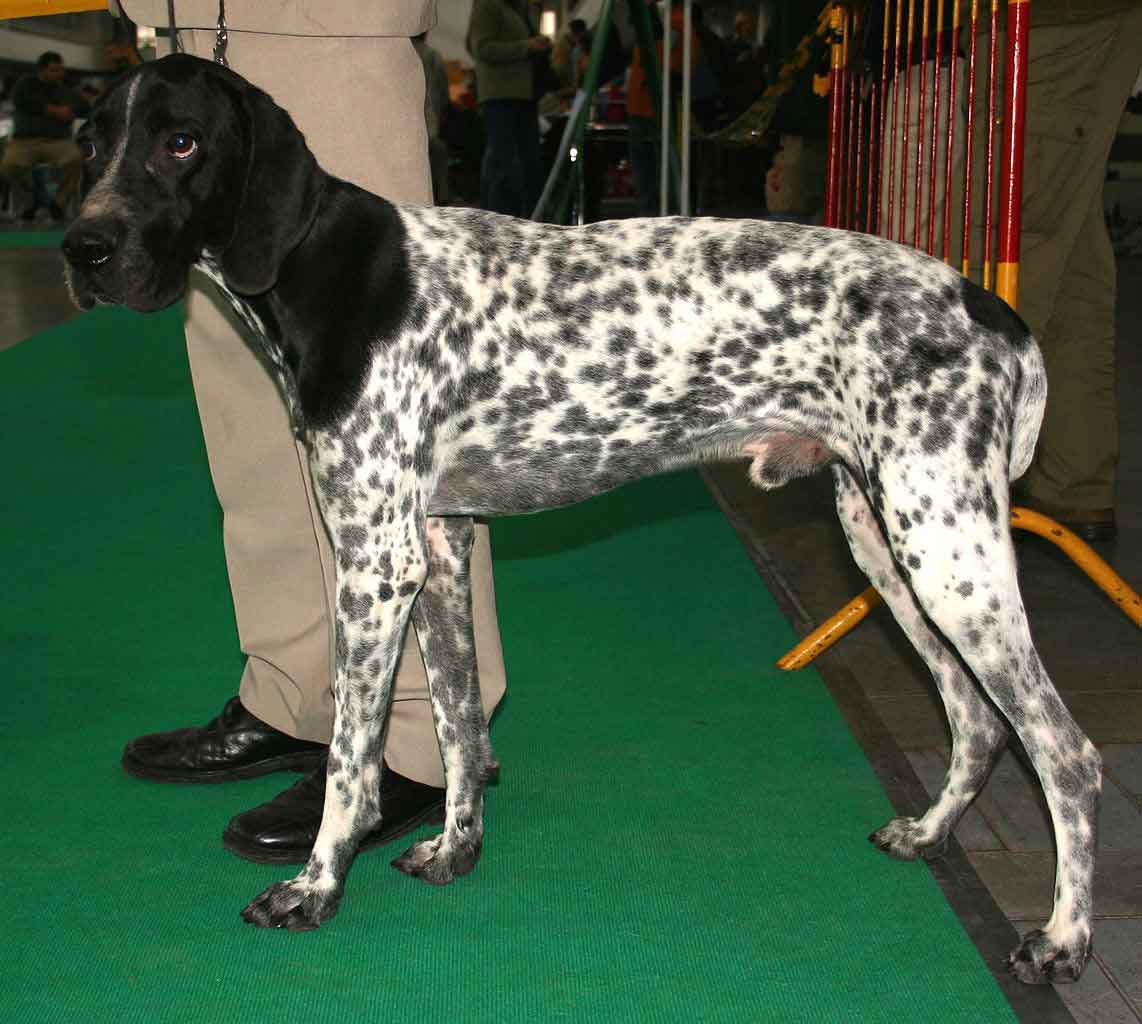
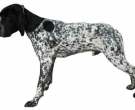
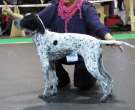
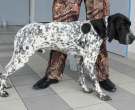
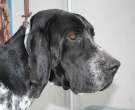
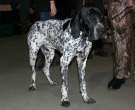
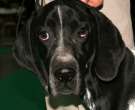
 Stopping of a snipe by a Braque d'Auvergne
Stopping of a snipe by a Braque d'Auvergne Burt (Braque d'Auvergne) Puppy Camp Dog Training Video Demonstration
Burt (Braque d'Auvergne) Puppy Camp Dog Training Video Demonstration braque d'auvergne
braque d'auvergne Braque D’Auvergne learning to point
Braque D’Auvergne learning to point
I have an Auvergne shorthaired pointer and I had an older one that already died and although it is true that they are meek and noble as could be, my dogs at least, they were and are dumber than a stone hahaha. But they are very very good and extremely sociable